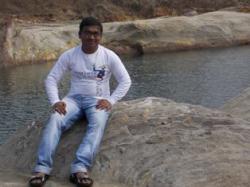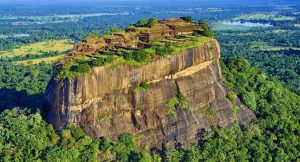Last Updated: July 11, 2019 Sudip Dey
Though Brahma (Brahmo) or the supreme soul is nirakara (without any shape or form), yet devotees from time to time has associated his existence with several myths where s/he is described as sakara (with shape). Since time immemorial in countries across the globe that Eternally Limitless Power is worshipped as a feminine identity and has been referred to as Mother. In India, this deity constitutes the central part of one of the primary schools of Devotional Hinduism where she is described as the energy of Shiva, the purifier or destroyer of evil. Sati and Parvati are believed to be her earthly incarnations. While the former is described as the daughter of Prajapati Daksha and the latter is described as the daughter of Himalaya, the king of all mountains. To signify their presence in this world a number of temples are built in and around the country which are connected inseparably to the death of Sati and resulting incident. With the passing time, these temples are developed into grand palace like structures and as a result have turned into revered Pilgrimage Destinations in India.
Mythological Reference behind the Formation of Shaktipeethas
Prajapati Daksha, the son of Brahma, the creator of this world mediated to get Aadi Shakti as one of his daughters. She appeared and fulfilled his wish on one condition that if she was ever hurt, she would leave the earthly home instantly. After her birth she was destined to marry Shiva, one of the three principal deities behind the creation of this entire world. Daksha used to dislike Shiva for his simple lifestyle and his residence on cremation ground. But despite all his objections Sati got married to Shiva. Later, Daksha organized a great Yagna inviting all dignitaries including Brahma and Vishnu except Shiva just to insult him. Sati came to know about this celebration and left for her paternal home without listening to Shiva’s advice. On reaching there she faced extreme forms of insult and after hearing all the derogatory words used against Shiva she sacrificed her life then and there. When the Mahadeva came to know about Sati’s demise, he got a severe shock and started a destructive dance lifting her dead body on his shoulder. The entire world started trembling with the steps of his feet. Seeing this Vishnu chopped the corpse into 51 pieces with all these parts falling in different parts of Asia. All these 51 places are later transformed into popular places of worship and transformed into awe-inspiring temples under the royal patronage of different times. Let’s have a look at these Popular Shaktipeethas in India around which the beliefs of entire Shakta school revolves.
Kamakhya Temple in Guwahati, Assam- “Where the Deity Completes her Fertility Cycle”
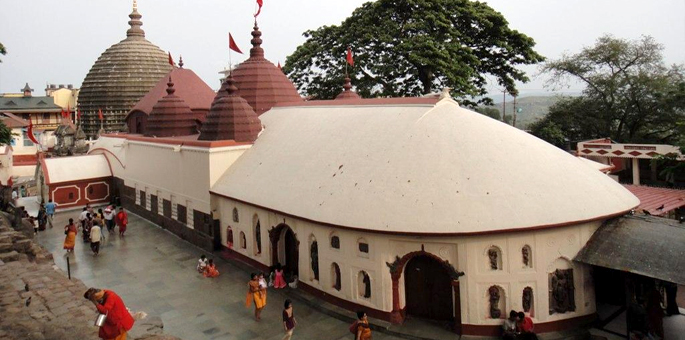
The presiding deity of Assam, Kamakhya resides on the mountain of Nilachal in Guwahati. One of the most famous Shakti Peetha Temples in India, the seat of Maha Shakti (supreme energy) this temple is associated with several mysticism and attract thousands of domestic as well as international devotees during the festival of Ambubachi Mela. According to Devi Purana, Sati’s Mahamudra( female reproductive organ) fell in a cave which is worshipped here in the form of a stone. It is believed that from mid June the deity Kamakhya starts menstruating which continues for three long days; during this period no homage is offered to the deity. The temple complex comprises several other temples dedicated to Shiva and different incarnations of Durga.
Remarks: Take a dip in Saubhagya Kunda for a bright future. Collect Kamsindur for the wellbeing of the household, business or married life. Devotees visiting this temple get rid of ailments and the deity protects them from all evil spirit.
Tripura Sundari Temple in Udaipur, Tripura- “The earthly abode of Tripura’s Protector”
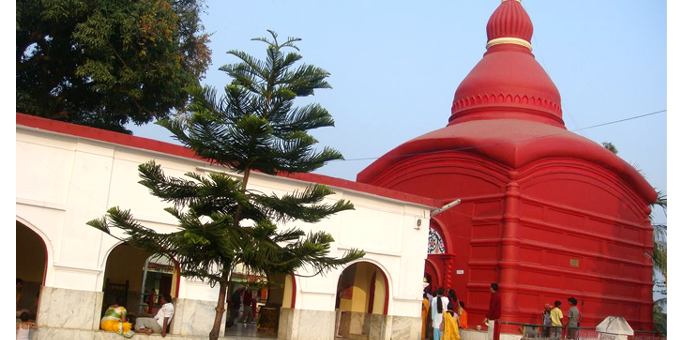
Popularly known as Matabari (the abode of Mother), Tripureshwari is a temple located on the outskirts of the south-western town of Udaipur in the state of Tripura. Around 51 km from Agartala city, the temple is located in a serene environment where the clamor of so called city life gives way to the chanting of hymns by the priests, sound of bells and the noise of shopkeepers inviting the devotees to buy puja samagri. The right foot of Sati fell on this spot and the deity is worshipped here in the form of a sixteen year old girl called ‘Soroshi’. The sanctum is built in square shape which resembles a normal Bengali hut. Animal sacrifice is an inseparable part of the daily puja. There is a huge pond behind the temple where various species of fish can be seen.
Remarks: People often visit this temple to fulfill their wish and it is believed that once a wish reaches the Goddess, it gets surely fulfilled.
Tarapith Temple in Birbhum, West Bengal- “Hub of Tantrik practices”

A mystical shrine on the Birbhum District of West Bengal, Tarapith is an ancient temple dedicated to one of the 12 incarnations of Goddess Kali called Tara. It is said that the eye ball (tara) of Sati dropped here. A hub of tantric activities, offerings, and all supernatural deeds, a smasana (crematorium) is located next to this temple. The quaint background, myths associated with it and beliefs transform the temple into one of the must see religious tourism places in India. The face of the deity is made of silver and unlike other forms of Kali she has got two hands. She is wearing a garland of snake and Shiva is found sucking her breast in the form a kid. Offering of blood is a must to conduct the daily puja and that is why every morning goats are sacrificed on the altar of the temple.
Remarks: It is believed that people visiting Tarapith temple never go back with empty hands. The deity is worshipped here in her motherly form.
Nalateshwari Temple in Birbhum, West Bengal- “Rendezvous with Unparalleled Serenity”

A calm and composed temple town sanctified by the water of River Brahmani, Nalateshwari is a temple dedicated to one of the incarnations of Goddess Kali. Here the vocal chord with part of the tracheae had fallen. The temple is located on a small hillock. The temple wall contains beautiful panels of terracotta. The belief goes like this: if one ties red or yellow threads on the trunk of a holy tree present there, one’s wish gets fulfilled.
Remarks: No matter how much water is poured down the throat it neither gets overflowed nor dries up.
Kalighat Temple in Kolkata, West Bengal- “Seat of the unique Idol of Goddess Kali”
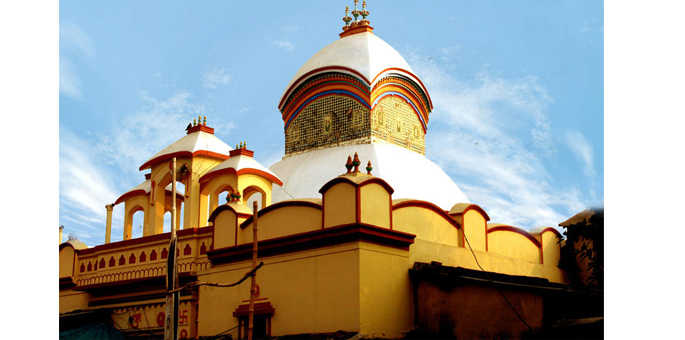
Located on the banks of a small canal Adi Ganga, Kalighat is one of the major attractions of Kolkata city. It is said that the toes of the right foot of Sati is worshipped here. The temple is associated with the Nath/Siddha tradition which speaks about different forms of yoga. Here the idol of goddess Kali is unique from other temples. Instead of a huge idol of the deity her image is made of black stone with three huge eyes, a long protruding golden tongue and four golden hands. On the day of Snanaytara while giving her a holy bath, the priests cover their eyes with cloth. Religious people visiting Kolkata do not miss out visiting this temple.
Remarks: Tuesday, Saturday and Ashtami are the special days for worshipping.
Vishalaskshi Devi Temple in Varanasi- “Home of a wide eyed deity”
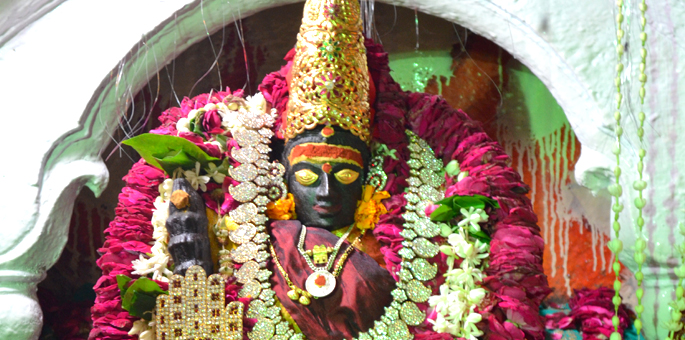
A temple built on the holy land of Varanasi, the abode of deity Vishalakshi is one of the best destinations for pilgrimage holiday in india. Found on the banks of Ganges at Uttar Pradesh this is a divine land where the earrings or eyes of Devi Sati fell. Here the deity Vishalakshi is described as the shakti of Lord Vishwanath (manifestation of Shiva) and the temple is strategically built in Meer Ghat behind the Vishwanath temple of Varanasi. Apart from the Shaktipeeth, Varanasi is also known for its popular bathing ghats and various temples which are associated closely to ancient Hindu beliefs. Manikarnika Ghat is one of the holiest Hindu cremation grounds and it is believed that people taking their last breathe in Varanasi or cremated on this Ghat get liberated from the cycle of rebirth and merge with the supreme entity of Shiva. Ganga aarti at Banaras Ghat is a must behold site in Varanasi.
Remark: Unamarried girls worshipping deity Vishalakshi get their deserved partner. Childless couples are blessed with a child or people visiting the temple without any special wish are bestowed with good fortune.
Madhaveshwari Devi Temple in Allahabad- “Residence of Nirakara Divine Being”
A shrine on the heart of Tirtharaj Prayag(king of all pilgrimages), Madhaveswari Devi Temple is dedicated to Goddess Lalita or Alopi Mata. Prayag is considered as one of the Sapta Mokshapuras (seven destinations of liberation) and a visit to this temple of Shakti is believed to be of great value. Legends say that hand fingers of Sati fell here. Instead of an idol, a swing is worshipped here as the deity. Swami Brahmananda who was popularly known as Rakhal, the first president of Ramakrishna math, witnessed the goddess here as a small child with three Jatas hence she is also called Trijata.
Remark: Arati is held in the evening which is a must see sight.
Mangala Gauri Temple in Gaya, Bihar- “Home to a motherly incarnation of Shakti”
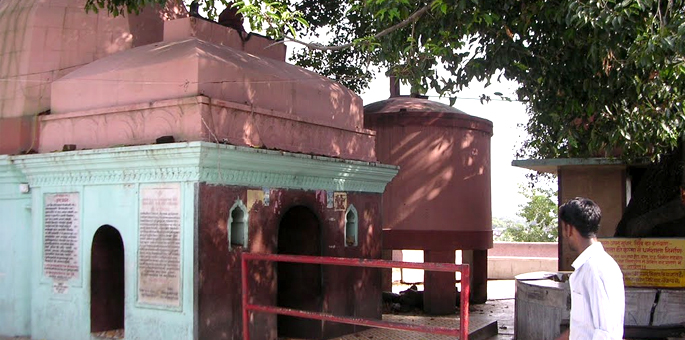
A spiritually ignited place thronged by the devotees all through the year, Gaya in the state of Bihar is the residence of this deity. Sati’s breast fell here and hence the temple does not contain any idol, instead, in the brass lamp lighting one can see a rock shaped breast like appearance. Tantrik preachers sacrifice different animals as offerings to the deity. The temple complex encloses the shrines of Shiva, Ganesha, Kali and some other forms of deities.
Remark: Do not forget to walk around the outer circle of the Lord Shiva temple.
Maha Kali Devi Temple in Ujjain- “Displaying a Fierce Form of Mother Goddess”
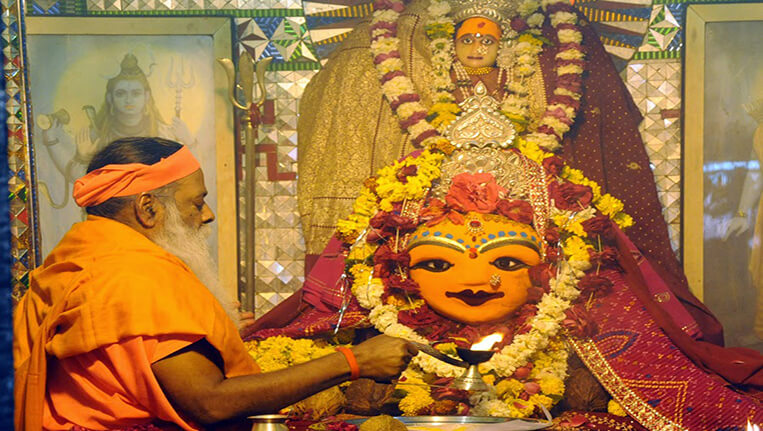
One of the most furious manifestations of Aadi Shakti, Maha Kali is worshipped in this temple. This pristine abode is located on a small hillock by the holy river Kshipra in the historical district of Ujjain, Madhya Pradesh. A city associated with a number of Hindu myths, Ujjain was the royal seat of Vikramaditya and Devi Mahakali was the presiding deity of his kingdom. The upper lip of Sati fell here and the deity is worshiped in her fierce form. Though Mahakali Devi Temple is not included in the Shaktipeethas, it makes for an important worship place for Goddess Kali’s devotees.
Remarks: Chaitra Navratri and Ashwin Navratri are the two most important festivals that are held in this temple. During daily offerings, Madira(alcohol) is presented to the deity.
Jwala Devi Temple in Kangra Valley, Himachal Pradesh- “Temple of Nine Undying Flames”
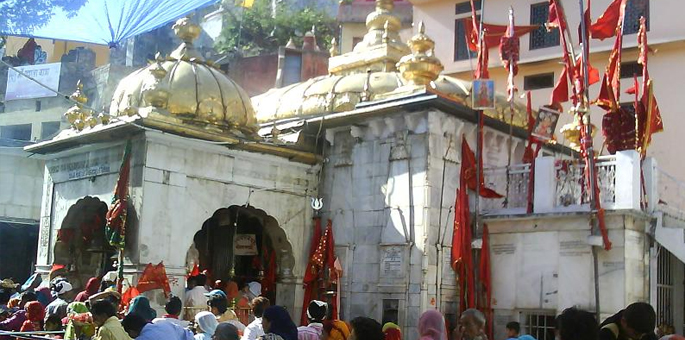
Centre of eternal beliefs, admiration, and sanctity, Jwala Devi temple is the abode of goddess Siddhida (Ambika). Located at a distance of 34 km south of Kangra Valley in Himachal Pradesh, this is one among the most visited temples in India where nine forms of the supreme deity are worshipped. Instead of idols, flames are worshipped as the manifestation of the deity. All these flames are seen to be erupting from the sides of a rock and they keep on burning constantly without any fuel. It is said that the tongue of Sati fell on this part. A divine earthly home of Shakti set amidst refreshing greenery, this temple displays a scenic view that rejuvenates your inner soul. The Seaja Bhawan of Jwala Devi depicts wonderful work of art especially the interiors.
Remark: Offering coconut in the Jwala devi temple is believed to be very fruitful.
Chintpurni Devi Temple in Una, Himachal Pradesh- “Temple of a headless deity”
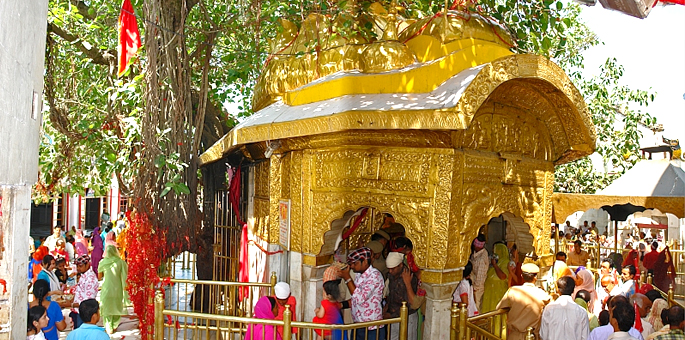
Located at a distance of 29 km from Jwala ji, Chintpurni Devi Temple is situated on Dharamshala-Hoshiarpur road on a ridge. The shrine is known to be one of the most visited temples of Goddess Shakti in North India because the forehead of Sati fell here. The main attraction of the temple is the idol of the central deity who is described in Puranas as a severed headed entity. The temple is located in Una district of Himachal Pradesh and bordered by the Western Himalaya in the north and the smaller Shiwalik range to the east.
Remark: To see the true colours of the grandeur of Chintpurni Temple, try visiting this shrine in the special festival organized during the 10 days of “Shukalpaksh” in August.
Girija Devi Temple in Jajpur, Odisha- “Shrine of Dwibhuja Mahishmardini”
Girija Devi or Biraja Devi temple is located in Jajpur, Odisha where goddess Durga is worshipped as the central deity. It is the name of the temple that gave this place the name of Viraja Kshetra. Here the deity is worshipped as dwibhuja (two handed) holding a trident in one hand and pulling the tongue of Mahish with the other. The navel of Sati fell here and it might be the reason why the place is known as Nabhi Gaya as well. Vaitarini River flows through the Biraja Kshetra and the deity is worshipped here as Trishakti Mahakali, Mahalakshmi, and Mahasaraswati.
Remark: Adhya Stotram written by Adi Shankaracharya includes the name of the deity. During Sharadiya Durga Puja held in the month of Ashwin (October-November) animal sacrifices take place.
Chamundeshwari Temple in Mysore, Karnataka- “Portal of Sanctity and Power”

A shrine dedicated to the fierce form of Shakti, Chamundeshwari temple is the most popular temple of goddess Shakti in South India. Located in Chamundi Hills of Mysore, this serene place is believed to be sanctified by the hair from Sati’s dead body. Located at a distance of around 15 km from the famous Mysore Palace, this temple is the worshipping place of Chamunda, the slayer of Chanda and Munda. Chamunda is an ancient Indian deity who has been referred to in ancient Indian texts such as Devi Mahatmya, Varah Purana and Matsya Purana and she is often described as one of the Sapta-Matrikas (seven mothers). In Chamundeshwari temple, she is worshipped as Ashtabhuja (deity with eight hands) seated on a lotus flower. This imposing shrine is claimed to be around thousand years old and depicts the best instance of Dravidian School of Architecture.
Remark: The first Friday of the Hindu month of Ashad (June last-July Mid) is believed to be an ideal time for visiting this temple. Dussehra festival in October is a not-to-miss ceremony.
Ekaveerika Devi Temple in Mahur, Maharashtra- “Taste the unmatched Divinity of Unique Prasadam”

Lesser known yet no less important, Ekaveerika Devi Temple is located in Mahur, Maharashtra. It is said that the right hand of Sati fell in this part. Unlike other Shaktipeethas, the temple is not crowded and thus one can communicate with the deity in a placid environment. The central deity of the temple is Renuka Devi; Ekaveerika Devi is believed to be the elder sister of this deity. Despite the shrine of Ekaveerika, the vicinity of this temple houses several other seats of the Hindu deities such as Parasurama temple, Dattatreya Swami temple, Anasuya mata temple, Atri Maharishi temple, Matru tirtha and Devdeveshwar mandir.
Remark: The main attraction of this temple is the Prasadam which is made grinding betel leaves and nut together.
Mahalaxmi Devi Temple in Kolhapur, Maharashtra- “Where Sun pays homage to the deity”
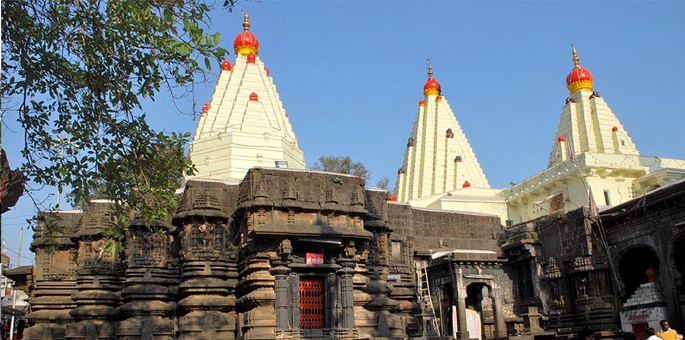
Popularly known as Shree Pitham, this glorious temple is the seat of Kolhapureshwari (the presiding deity of Kolhapur). It is believed that the eyes of Sati fell here. There is a huge difference between the commonly found Laxmi idol and the image found in this temple. Here the lion is portrayed as the mount of the deity. In Mahalaxmi Temple of Kolhapur, the idol of the deity is carved in black stone and she has four hands holding a mhalunga (a citrus fruit) a Kaumudoki (large mace), a khetaka (shield) and a panpatra. The main attraction of the temple is a small open window on the western wall through which rays of the setting sun fall directly on the deity’s face on the 21st of each March and September.
Remark: There are six fixed days in each year when sunrays enlighten different parts of the idol of the deity. On those days Kirnotsav festival is organized.
Jogulamba Devi Temple in Mahbubnagar, Andhra Pradesh- “Witness a deity with weird matted lock”
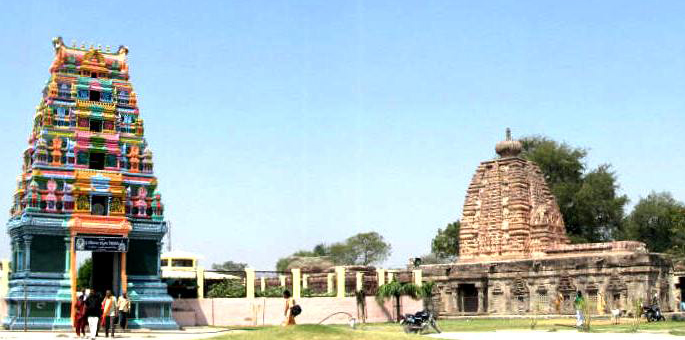
A temple dedicated to the incarnation of Parvati, Jogulamba Devi Temple is located in the town of Alampur in Mahbubnagar district of Andhra Pradesh. According to legends the upper jaw and teeth of Sati fell here. The temple is placed in a sacred location at the confluence of the Krishna and Tungabhadra River. Jogulamba and Brahmeshwara are the two central deities of this temple. The main attraction of this temple is the idol of Jogulamba who has long hair with lizards, scorpion, bats and human skulls hanging from them. Other companions of Jogulamba are Veerabhadra, Vighneshwara and Saptmatrikas.
Remark: The deity is worshipped by the devotees suffering from Vastu Dosha. Dussera, Mahashivratri are celebrated here with great pomp and gaiety.
Bhramaramba Devi Temple in Kurnool, Andhra Pradesh- “Where Shiva and Shakti remain vigilant”

One of the 18 manifestations of Shakti mentioned in Adya Stotram, Bhramarambika Devi is worshipped here. Located at a distance of 212 km south of Hyderabad and 179 km from Kurnool, this is a temple located on the banks of Krishna River on top of Nallamala in Kurnool District of Andhra Pradesh. It is believed that a part of Sati’s neck fell in this place. Despite being a Shaktipeeth, the temple draws crowd for encompassing one of the 12 jyotirlingas of lord Shiva called Mallikarujun Swami. It is for these two temples that Srisailam is known as Siddhi Kshetra. Here Goddess Durga is worshipped as Brahmani Shakti. Bhramari means the mother of bees and coincidentally inside a granite wall at the back of the temple a huge number of bees are found buzzing.
Remark: Navaratri Festival is celebrated here with grand celebrations. A local festival called Kumbham is organized here in the month of Chaitra (March-April).
Puruhutika Devi Temple in East Godavari, Andhra Pradesh- “Plunge into the Pool of Holiness”
Located in a serene locale of Pithapuram village in the district of East Godavari in Andhra Pradesh. Puruhutika Devi Temple is a destination to get rid of all sins. Found amidst a couple of other temples, this is a shrine of Mother Goddess where the left hand of Sati was supposed to have fallen. One of the three Gayas, called Pada Gaya is located in this place where a visit is supposed to be good for one’s luck. Puruhutika Devi is believed to be the consort of Kukkuteshwara Swamy and that is why the former’s abode is found in the latter’s temple complex. The deity Puruhutika is found here with four hands holding a bag of seeds (Beeja), axe (Parashu), lotus (Kamala) and a dish (Madhu patra) from lower-right to lower-left in order.
Remark: One should have a look at the temples of Hunkruthi Durga, Rajarajeswari temple, Kunthi madhava temple and Sripada Srivallabha Dattatreya temple.
Manikyamba Devi Temple in East Godavari, Andhra Pradesh- “Where the Deity Looks Always to the Left”
A divine spot associated with several myths and tales and worshipped by many Shaktas, Manikyamba devi Temple become popular for its unique idol of the deity. It is believed that the deity was initially worshipped by the Bamachari sect of Hinduism and that is why the eyes of the idol are slightly tilted towards left. According to the Devi Purana, the left cheek of Sati fell here. Another legend states about the association of the deity with prostitutes and that is why she is also known as the Kuldevi of sex workers of that region. The temple is located at Drakshrama in East Godavari District of Andhra Pradesh.
Remark: Friday is an important day for Manikyamba devi Temple, as on this day Kumkumarchana is done. Every Ekadashi, ekanta seva of Lord Bhimeswaraswamy and Manikyamba devi is performed.
Danteshwari Temple in Bastar, Chhattisgarh- “Home of Rescuer Maiji”

A center of belief, dependency and hope for the tribal as well as non-tribal people of Dantewada, Danteshwari Temple is a revered Shaktipeeth dedicated to goddess Durga. It is believed that the teeth of Sati fell here and the temple got the name from the same connection. The temple dates back to almost 600 years and she is believed to be the presiding deity of Kakatiya Dynasty. The temple is located at the confluence of the holy rivers Shankini and Dhankini which are bestowed with different colours of water. The deity is known as Danteshwari Mai and the tribal people worship her as their only saviour deity.
Remark: Dussera celebration is a grand festival when thousands of tribal people assemble together in this temple and take the deity out for a grand procession.
Spiritual tourism in India comprises an integral part of travelling since time immemorial. Significantly, the temples of Shakti have always remained centre of attraction due to the mysticism associated with them. Most of these temples are built under the patronage of different dynasties and depict a unique architectural style. Moreover, the idols of the deities are mostly carved out of stone and many of these images are believed to be self incarnated. However a visit to the 18 temples mentioned in ‘Adya-Stotram’ brings prosperity, liveliness, saves one of from all danger and most importantly saves one from the cycle of rebirth. However, the Shakti Peethas at Kamakhya, Gaya and Ujjain are described as the holiest and most fruitful temples as they depict three most important aspects of the feminine deity i.e., Creation (Kamarupa Devi), Nourishment (Sarvamangala Devi/Mangalagauri) and Annihilation (Mahakali Devi).
Published: 05 Aug, 2014
From the tranquil land of Silchar, Assam, Sudip is a nature enthusiast. An avid wildlife lover and a history buff, Sudip likes to explore and capture the best through his lens. He aims at working towards the conservation of biosphere and desires to promote the rich heritage of India. As a traveller, Sudip has extensively explored North-East India. When he is not travelling, Sudip likes to read novels and write travel and lifestyle blogs.



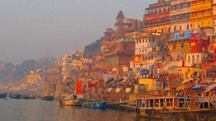 15 Nights / 16 Days
15 Nights / 16 Days 13 Nights / 14 Days
13 Nights / 14 Days 2 Nights / 3 Days
2 Nights / 3 Days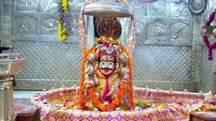 23 Nights / 24 Days
23 Nights / 24 Days















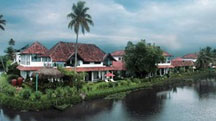 13 Nights / 14 Days
13 Nights / 14 Days 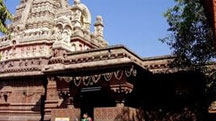 4 Nights / 5 Days
4 Nights / 5 Days 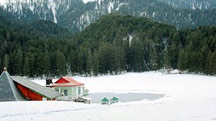 10 Nights / 11 Days
10 Nights / 11 Days 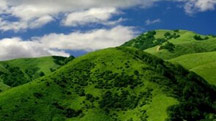 8 Nights / 9 Days
8 Nights / 9 Days 